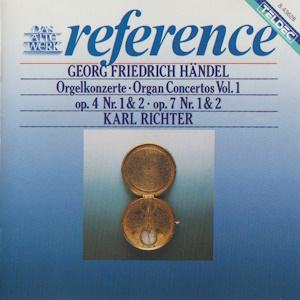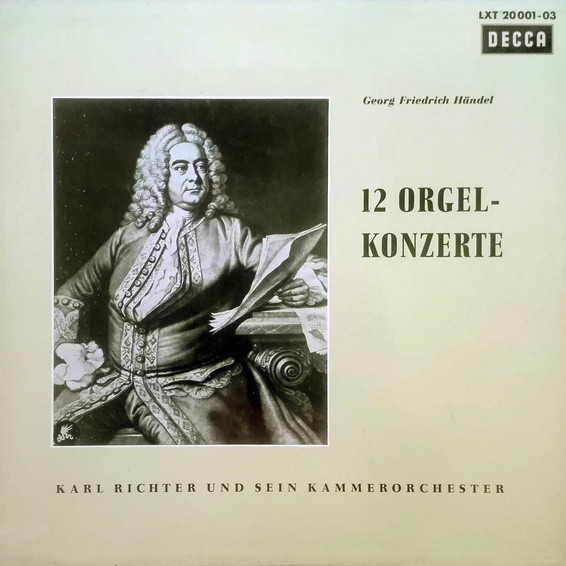 |
| 1 CD -
8.43628 ZS - (c) 1987 |
 |
3 LP -
LXT 20 001-03 - (p) 1959
|
|
ORGELKONZERTE - Vol. 1
|
|
|
|
|
|
|
|
|
|
| Georg Friedrich
HÄNDEL (1685-1759) |
Orgelkonzert
g-moll, Op. 4 Nr. 1 |
|
17' 17" |
|
|
|
- Larghetto, e
staccato |
5' 57" |
|
1 |
1-A1
|
|
- Allegro |
5' 27" |
|
2 |
1-A2
|
|
- Adagio |
1' 15" |
|
3 |
1-A3
|
|
-
Andante
|
4' 38" |
|
4 |
1-A4
|
|
Orgelkonzert
B-dur, Op. 7 Nr. 1 |
|
16' 29" |
|
|
|
- Andante |
4' 48" |
|
5 |
2-B1
|
|
- Andate
(Passacaglia) |
4' 37" |
|
6 |
2-B2
|
|
- Largo, e piano
|
4' 07" |
|
7 |
2-B3
|
|
-
Bourrée: Allegro
|
2' 57" |
|
8 |
2-B4 |
|
Orgelkonzert
B-dur, Op. 4 Nr. 2 |
|
10' 34" |
|
|
|
-
A tempo ordinario, e staccato |
0' 58" |
|
9 |
1-A5 |
|
-
Allegro |
5' 07" |
|
10 |
1-A6 |
|
- Adagio, e
staccato
|
0' 49" |
|
11 |
1-A7 |
|
- Allegro, ma non
presto
|
3' 40" |
|
12 |
1-A8 |
|
Orgelkonzert
A-dur, Op. 7 Nr. 2 |
|
12' 20" |
|
|
|
- Ouvetüre |
3' 26" |
|
13 |
2-B5 |
|
- A tempo
ordinario
|
4' 24" |
|
14 |
2-B6 |
|
- Organo ad
libitum (Adagio)
|
0' 21" |
|
15 |
2-B7 |
|
- Allegro |
3' 09" |
|
16 |
2-B8 |
|
|
|
|
|
Karl
RICHTER, Orgel
|
| und
sein Kammerorchester |
|
|
|
|
Luogo
e data di registrazione |
|
St.
Mark's Church, Munich (Germany) -
May & July 1958
|
|
|
Registrazione:
live / studio |
|
studio |
|
|
Producer |
|
-
|
|
|
Prima Edizione
LP |
|
Decca
- LXT 20 001-03 - (3 LP) - durata
2h 35' 25" - (p) 1959 - Analogico
|
|
|
Edizione
"Reference" CD
|
|
Tedec
- 8.43628 ZS - (1 CD) - LC 3706 -
durata 55' 07" - (c) 1987 - AAD |
|
|
Cover |
|
Foto mit
freundlicher Genehmigung des
Museums für Kunst und Gewerbe
Hamburg |
|
|
Note |
|
The
Karl Richter edition of these
organ concertos by Handel
published in 1959 is here
reproduced on three compact discs
by TELDEC in the "reference"
series. Oddly enough, the first
volume (blue series) contains
Concertos Nos. 1 and 2 of Op. 4
and Op. 7; the second volume
(brown series) contains Concertos
Nos. 3 and 4 of Op. 4 and Op. 7;
the third volume (green series)
contains the Concerts Nos., 5 and
6 of Op, 4 and Op. 7. The multiple
editions published instead contain
the 6 Concertos of Op. 4 and to
follow the 6 Concertos of the Op.
7.
|
|
|
|
|
Op. 4
No. 1
The G minor concerto op.
4/l is perhaps the
best-known, certainly
one of the most
attractive works of the
op. 4 set. Its structure
adheres to the Corelli
model of the concerto
grosso: a powerful G
minor larghetto that
enters with a motif full
of pathos is followed by
a tempestous allegro.
The allegro proceeds
initially from an
opening motif of
chiselled austerity,
almost wild in
character, but in the
third solo episode a
contrasting cantabile
theme is introduced -
one of the many features
in which this concerto
anticipates later
Classical principles of
composition. A brief
adagio for unaccompanied
organ leads into the
finely-spun filigree
finale, which has a
minuet-like elation
about it. Handel later
used this finale as the
last movement of the
trio sonata op. 6/5.
Op. 4 No. 2
The second work of the
set, which is probably
the so-called “Esther
concerto”, a favourite
with Handel’s audiences,
follows the same scheme.
A brief opening movement
with dotting producing a
mood of pathos is
followed by a virtuoso
allegro, based entirely
on the opening motif,
which Handel borrowed
from the trio sonata op.
2/4 (where it appears as
the finale). A short
adagio - essentially
nothing more than a
figuratively elaborated
organ cadenza - leads
into the minuet-like
finale in 3/8 time. As in
the first concerto, this
resolves the serious and
pathetic moods of the
preceeding movements
into courtly elegance
and playful virtuosity.
Op. 7 No. 1
A different world
ofexpression and form,
more expansive and
resplendent, opens up
with the first concerto
of op. 7, the only one
of Handel’s organ
concerti to expressly
require the use of the
pedals on the solo
instrument. The dialogue
of the opening andante
is splendidly colourful
and spaciously laid-out.
It is followed by a
passacaglia of grand
proportions, rich in
pathos and contrast. A
wonderfully ethereal,
flowing largo in muted
piano leads into the
concluding bourrée,
which breaks up the
serious weight of the
first movement with
graceful dance.
Op. 7 No. 2
Few traces of the
traditional concerto
form established by
Corelli are to be found
in the op. 7 set, and
the second concerto
shows absolute freedom
in its layout. A
pathetic introduction in
dotted overture rhythm
and a mighty fugued
allegro (with only two
solo episodes and a solo
cadenza) are merged to
produce French overture
form. This is followed,
after a brief
transitional
improvisation on the
organ that is more of an
appendix than a
balancing counterweight,
by a concertante allegro
as a lighter-toned,
joyful finale.
Translation:
Clive R. Williams
|
|